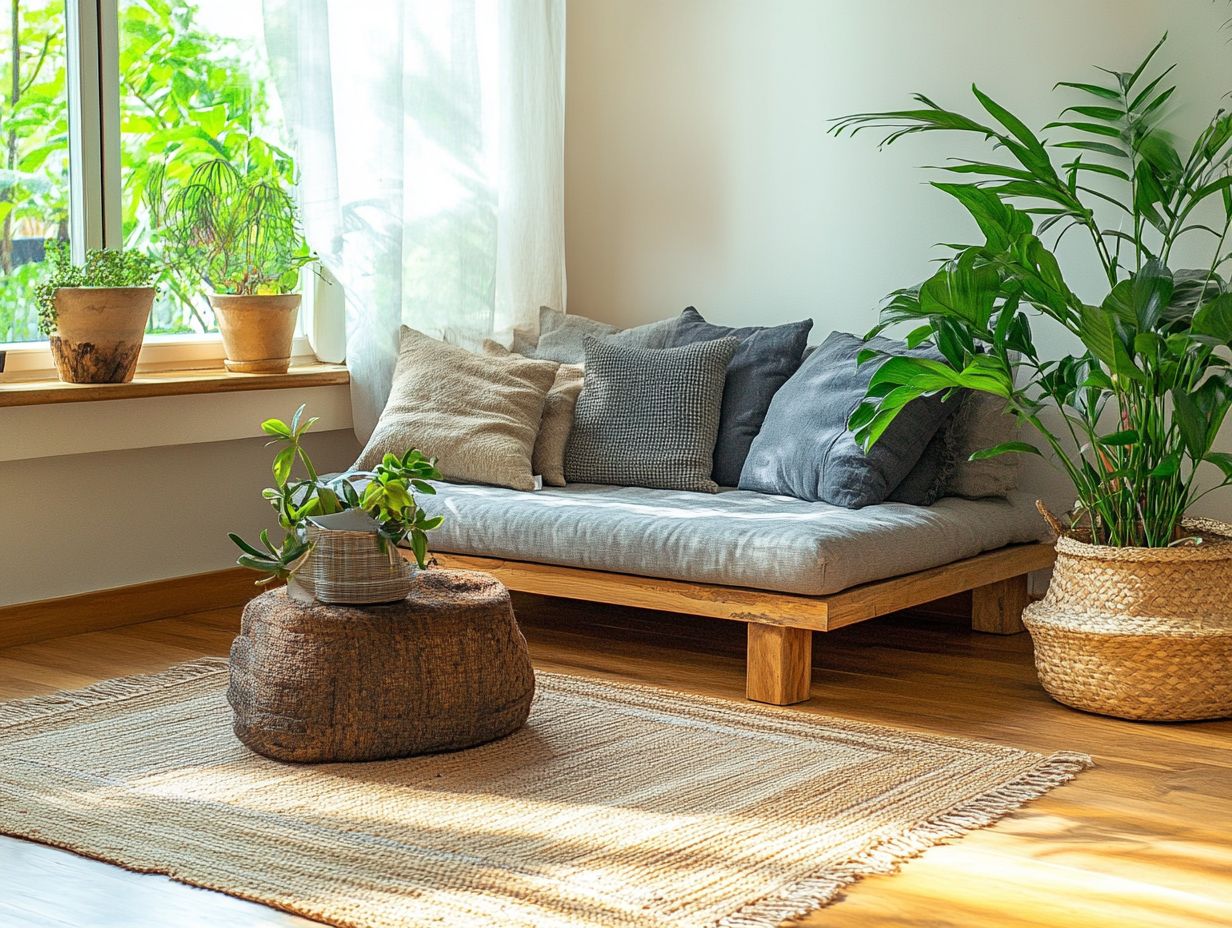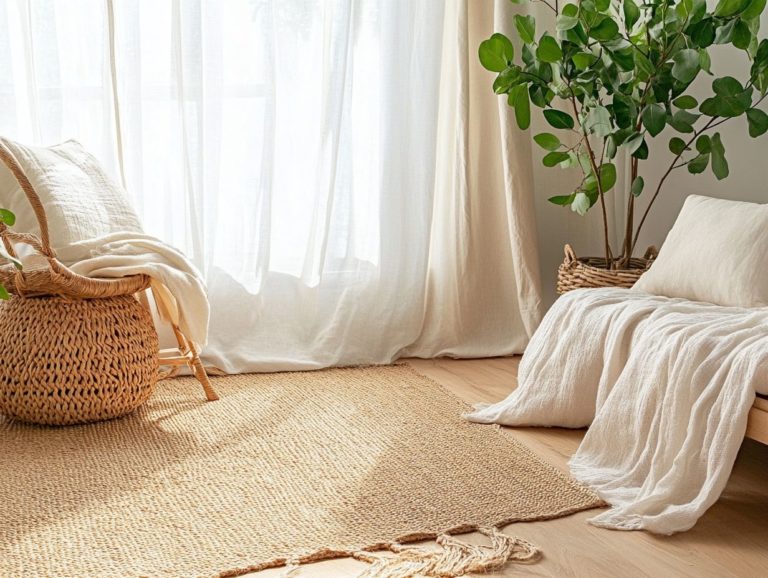How to Choose Sustainable Materials for Your Home
In a world that is becoming increasingly attuned to environmental concerns, selecting sustainable materials for your home holds paramount importance. This exploration delves into the reasons why choosing eco-friendly options not only nurtures the planet but also elevates the beauty and functionality of your living space.
From grasping the environmental impacts and cost considerations to uncovering the diverse range of sustainable materials available, you ll discover practical insights for seamlessly integrating them into your home design. Delve into the multitude of benefits that sustainable materials offer, paving the way for a healthier and more eco-conscious lifestyle.
Contents
- Key Takeaways:
- The Importance of Sustainable Materials
- Factors to Consider When Choosing Sustainable Materials
- Types of Sustainable Materials
- How to Incorporate Sustainable Materials in Your Home
- Benefits of Using Sustainable Materials in Your Home
- Frequently Asked Questions
- What s the real impact of choosing sustainable materials for my home?
- Why should I choose sustainable materials for my home?
- What are some examples of sustainable materials for my home?
- How can I ensure that the materials I choose are truly sustainable?
- Are sustainable materials more expensive than traditional materials?
- Can I still have a stylish and modern home using sustainable materials?
Key Takeaways:

- Reduce your environmental impact by choosing sustainable materials for your home.
- Assess factors like environmental impact, cost, durability, and availability when selecting sustainable materials.
- Incorporate recycled, natural, and renewable materials in your home design to benefit both the environment and your health.
The Importance of Sustainable Materials
Sustainable materials play a pivotal role in today’s construction landscape, providing solutions that not only cut down on carbon emissions but also boost energy efficiency in your home. By utilizing eco-friendly materials like bamboo, reclaimed wood, and sheep’s wool, you can make a fantastic impact on the environment while ensuring your structures are durable and resilient. To learn more about keeping these materials in top shape, check out this guide on how to maintain sustainable home materials.
As the construction process evolves, embracing these materials paves the way for a greener future. Supporting the local economy is another key benefit, helping to minimize your carbon footprint and contributing to sustainable architecture.
This choice is essential in modern building practices, fostering a healthier living environment for families.
Why Choose Sustainable Materials for Your Home?
Choosing sustainable materials for your home is a significant decision. It enhances your energy efficiency and actively reduces carbon emissions. To make informed choices, you can learn how to research sustainable materials for your home, contributing to a greener planet.
When you opt for eco-friendly options, you can see substantial savings on your energy bills, thanks to improved insulation and reduced reliance on heating and cooling systems. These materials often lead to healthier indoor environments, minimizing the presence of toxic chemicals that are all too common in traditional construction materials.
Utilizing locally sourced sustainable materials actively supports the local economy and reduces transportation emissions, reinforcing your commitment to environmental stewardship. By prioritizing sustainability in your construction choices, you play a crucial role in fostering a healthier future for both yourself and the planet.
Factors to Consider When Choosing Sustainable Materials
When you select sustainable materials for construction, several key factors come into play. You need to consider the environmental impact, durability, cost, and availability to ensure that the materials you choose align seamlessly with the principles of sustainable architecture.
Environmental Impact
The environmental impact of construction materials is crucial in the fight against climate change. By opting for environmentally friendly options, you can significantly reduce carbon emissions throughout the building process.
Prioritizing sustainable alternatives like reclaimed wood, recycled steel, and low-VOC paints enhances the durability and aesthetic appeal of your projects while contributing to a healthier planet. A method to evaluate the environmental impact of materials from start to finish serves as an essential tool to quantify the overall environmental footprint of various materials, from extraction to disposal, ensuring that your choices align with sustainability metrics.
By implementing these eco-conscious practices, you can minimize waste and energy consumption, fostering a construction culture that champions both innovation and environmental stewardship.
Cost and Availability

Cost and availability are paramount when selecting sustainable materials. These elements directly influence the feasibility of your eco-friendly construction projects.
Your success in achieving sustainability relies on balancing affordability, quality, and energy efficiency. When evaluating potential materials, consider market accessibility. It plays a crucial role in dictating your options and affects the long-term viability of your choices.
The implications extend beyond purchasing decisions. They influence project timelines, labor costs, and your overall environmental footprint. Therefore, be strategic in your selections. Ensure that the materials you choose fulfill aesthetic and functional requirements while aligning with the principles of sustainable development and responsible resource management.
Durability and Maintenance
Durability and maintenance are crucial factors for sustainable materials. They influence the long-term performance and energy efficiency of your green home.
Look closely at materials like bamboo and reclaimed wood. Their natural durability not only extends their lifespan but also lowers lifecycle costs. Bamboo is renowned for its impressive strength and wear resistance, often outperforming traditional hardwoods and reducing the need for frequent replacements.
Reclaimed wood, sourced from decommissioned structures, brings unique character and offers remarkable longevity and stability. Choose these sustainable options to minimize maintenance demands and conserve resources, leading to reduced expenses and a smaller environmental footprint over time.
Types of Sustainable Materials
Explore the exciting variety of sustainable materials available today. Each presents distinct advantages and plays a vital role in eco-friendly construction practices.
Consider the benefits of recycled materials, the elegance of natural options like bamboo and cork, and the appeal of other renewable resources. Each choice enhances your project and contributes positively to the environment.
Recycled Materials
Recycled materials are the backbone of sustainable construction. They offer eco-friendly options that significantly minimize waste and curtail the consumption of new resources.
Choose reclaimed wood, recycled steel, and repurposed concrete to craft structures that conserve natural resources and infuse unique aesthetic qualities into your projects. Imagine the charm of reclaimed wood, salvaged from old buildings or furniture, bringing warmth to your new homes. Recycled steel boasts strength and durability while reducing the demand for new metal production, which in turn lessens the carbon emissions tied to manufacturing.
Repurposed concrete can be crushed and transformed into aggregate for new mixes, fostering a circular economy in the construction industry. Embracing these materials offers significant environmental advantages and sparks innovative architectural designs that stand out in an ever-evolving landscape.
Natural Materials
Natural materials like bamboo, sheep’s wool, and cork are increasingly popular in sustainable construction. They provide exceptional thermal insulation which helps keep buildings warm in winter and cool in summer and moisture resistance while being biodegradable.
These eco-friendly choices help reduce the carbon footprint of your buildings and create healthier indoor environments. When utilized effectively, these materials can enhance the aesthetic appeal of your structures, providing a warm and organic feel that synthetic alternatives often lack.
Their durability ensures they withstand the test of time, translating to long-term cost savings for homeowners and builders alike. By embracing natural materials, you foster a deeper connection to nature, reflecting a commitment to sustainability that resonates with environmentally conscious consumers.
Renewable Materials

Renewable materials are essential to sustainable architecture, offering eco-friendly choices that enhance energy efficiency and reduce carbon footprints.
These materials, like bamboo, reclaimed wood, and cork, are sourced through sustainable practices that minimize environmental impact. Take bamboo, for example: it s not only fast-growing but also remarkably strong, making it an excellent option for structural components.
Reclaimed wood adds a unique charm and a sense of history to your spaces while alleviating the need for new timber. Then there’s cork, harvested from the bark of cork oak trees, which provides outstanding insulation properties and is entirely renewable.
The uses for these materials go beyond just flooring and framing; they can elevate interior finishes, create acoustic panels, and support green roofs, all contributing to a healthier living environment.
How to Incorporate Sustainable Materials in Your Home
Imagine transforming your living space! Incorporating sustainable materials into your home can truly elevate your living space, enhancing its aesthetic appeal and energy efficiency.
This choice not only transforms your environment but also reflects a commitment to an eco-friendly lifestyle, enriching your everyday experience.
Tips and Ideas for Sustainable Home Design
Sustainable home design can be realized through a variety of smart solutions, including the use of eco-friendly materials, optimizing energy efficiency, and implementing advanced insulation techniques. These methods help keep your home warm in winter and cool in summer.
By selecting renewable materials like bamboo or reclaimed wood, you can significantly reduce your environmental footprint and learn why your home needs more sustainable materials while enhancing your home’s aesthetic appeal.
Solar panels capture clean energy and lower your utility bills. Choosing energy-efficient appliances ensures that your energy consumption remains minimal, allowing your household to thrive comfortably while staying sustainable.
Incorporating proper ventilation systems is vital for improving air quality, while smart home technologies facilitate better monitoring and control of your energy usage.
Each of these elements works together seamlessly to create an eco-conscious living space that promotes a healthier lifestyle and positively impacts the planet.
Benefits of Using Sustainable Materials in Your Home
The advantages of incorporating sustainable materials into your home go far beyond mere environmental claims. You’ll discover substantial health benefits, enhanced energy efficiency, and impressive long-term cost savings that come with selecting sustainable materials for DIY projects in your living space.
Environmental and Health Benefits
The environmental and health benefits of sustainable materials are truly remarkable. By choosing these materials, you not only reduce carbon emissions but also enhance indoor air quality and your overall well-being.
These materials play a crucial role in significantly lowering pollution levels by minimizing the release of harmful chemicals into the atmosphere. You ll notice a decrease in respiratory issues and allergy symptoms in your community, ultimately improving quality of life for many individuals.
When you opt for products made from renewable resources, you contribute to healthier ecosystems, supporting biodiversity and helping to combat climate change.
As more industries embrace sustainable practices, the ripple effect can lead to cleaner air and a healthier population, highlighting the importance of making environmentally responsible choices.
Frequently Asked Questions

What s the real impact of choosing sustainable materials for my home?
Choosing sustainable materials means selecting options that have a smaller environmental impact, are non-toxic, and have a longer lifespan. It’s important to know what to look for in sustainable home materials, making them a more eco-friendly choice for your home.
Why should I choose sustainable materials for my home?
By choosing sustainable materials, you can learn how to make your home more sustainable with materials, reduce your carbon footprint, decrease your home’s energy consumption, and contribute to a healthier environment.
Start incorporating sustainable materials in your home today for a brighter, eco-friendly future!
What are some examples of sustainable materials for my home?
Examples of sustainable materials include bamboo, reclaimed wood (wood that has been reused from old buildings or furniture), recycled glass, and natural clay or plaster for walls. For more detailed information, check out this guide for homeowners.
How can I ensure that the materials I choose are truly sustainable?
Look for certifications like Forest Stewardship Council (FSC) and Cradle to Cradle (C2C). Research the company’s sustainability practices to confirm their commitment.
Are sustainable materials more expensive than traditional materials?
Some sustainable materials cost more upfront. However, they often last longer and can save you money over time through lower energy use and maintenance costs.
Can I still have a stylish and modern home using sustainable materials?
Absolutely! Many sustainable materials are visually appealing and help you achieve a modern look.
Seek out options with sleek designs and neutral colors. Transform your home into an eco-friendly sanctuary using stunning materials!






